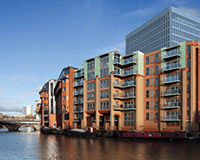The permitted development rights broom is sweeping through Bristol. Some 500,000 sq ft of offices could be removed from the market this year alone according to Knight Frank – Terrace Hill is converting Bristol Bridget House, for example – and CBRE estimates 1m sq ft of office space potentially disappearing in the long term.
Surely losing that much office stock cannot be good for the market, can it? In the short term it is solving the problem of an oversupply of secondhand stock which artificially inflates availability figures.
Knight Frank Bristol commercial partner Martin Booth says the conversion trend is a good thing but adds: “The impact on the office market to date is potentially less than you might first imagine because a good proportion of those buildings were obsolete.”
Some buildings were at least partially occupied – Crown House on Prince Street for example – and it has provided an opportunity for those occupiers to move at the bottom of the market with a cash incentive in their back pockets in return for surrendering a lease.
Phil Morton, director at DTZ, comments: “It will put pressure on other [office] buildings and will bring forward the reduction in incentives, then by the end of the year it will put pressure on the secondhand market to increase rents.”
Secondhand rents naturally vary depending on quality. You can pick up space for as little as £10 per sq ft with the very best secondhand stock fetching as much as £24 per sq ft.
It makes estimates for rental increases very difficult but Morton believes it will be the middle tier of the market which will see the most dramatic shift in deal terms.
Where the office to residential conversion trend is not having an effect is at the top end of the market. There are those who bemoan the reduction in office stock overall but the reality is that tenants who occupy most grade B are never likely to occupy brand new space.
In the longer term as the new speculative developments fill up there could be a shuffling of the pack as some businesses upgrade to better
secondhand stock. However, office to residential conversion is not the exclusive preserve of existing buildings but a number of office consents are also being changed – Crest Nicholson at Harbourside for example, has opted to build more residential instead of offices. And similarly Cubex at Finzels Reach (see panel, left).
But again there is not much concern as Bristol is not short of potential development sites for offices to satisfy future demand. The Temple Quarter Enterprise Zone around the station, for example, has the aim of creating 25,000 jobs in its lifespan albeit through a mixture of uses not just business space. So all in all it is a clean sweep for Bristol for the time being with all eyes on deal details in the next 12 months.
“PDR has saved a lot of agents a lot of time trying to let buildings that don’t fit what people want,” concludes Morton.
What the developers say
Adam Pratt, Terrace Hill
Terrace Hill is planning to convert Bristol Bridge House from offices to 60-plus residential units. It is in the process of establishing PDR and has also submitted planning for external alterations and an additional floor. Values will be in the region of £350 per sq ft. Pratt says: “Financially it is a more viable scheme. The problem with speculative office development, while there is demand there isn’t much transactional evidence and tenants still want flexible leases and that makes it challenging. But, I think that will change.”
Gavin Bridge, Cubex
Cubex, backed by Palmer Capital, acquired the Finzels Reach development portfolio out of administration last year and is looking to convert a 30,000 sq ft Grade II listed building with office consent to residential. A further 200,000 sq ft of new offices has consent and residential is being considered. Bridge says: “If we built out what was consented we would require prelets for at least a third of the [office] space to get funding. So why not break it down to apartment blocks do one ourselves and sell on the others?”
Not any building will do
PDR works for Bristol city centre at the moment because the values stack up – unlike office development. There is no affordable housing requirement and many developers are using it as a stepping stone to get full consent for more comprehensive work. However, the same market principles apply.
“A lot of the buildings are coming forward for student accommodation rather than residential,” says Ben Taylor of Savills.
“You do have to come up with a credible residential solution… people won’t just buy anything and not all buildings work. If you are sandwiched between two student blocks and some empty retail you probably don’t want to be there.”
JLL research shows that 3,000 student beds will be built in Bristol in 2014 and 2015.
Taylor says that current residential values in the city centre range from £250 per sq ft up to £400 per sq ft for waterside property.
But GVA’s James Taylor points out it is early in this market cycle.
He says: “I think more evidence is required to test demand for city centre residential, we will see how the new schemes go.”
One of those news schemes could be Terrace Hill’s Bristol Bridge House which the developer says is already receiving a lot of interest including from hotel operators.
stacey.meadwell@estatesgazette.com











